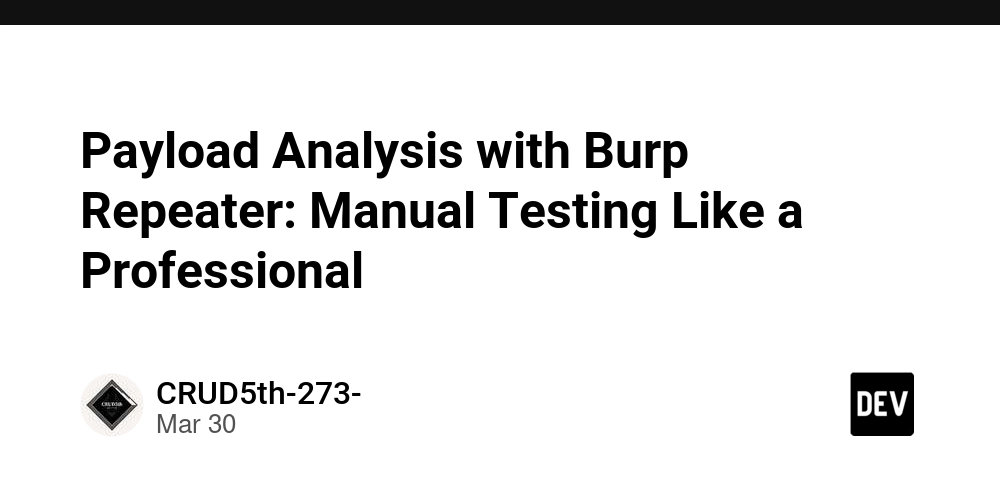Payload Analysis with Burp Repeater: Manual Testing Like a Professional
While automated scanners are fast, Burp Repeater remains the weapon of choice for fine-grained analysis. It lets you inspect, craft, and reissue requests in isolation — ideal for identifying edge-case vulnerabilities. This article focuses on how to effectively use Repeater for manual payload analysis during a web penetration test. 1. What is Repeater? Burp Repeater is a tool that lets you manually modify and resend HTTP requests to a target server. Each request/response pair is preserved, enabling precise observation of changes in behavior. Perfect for: Parameter tampering Authentication bypass testing Input validation exploration Confirming false positives from scanners 2. Sending Requests to Repeater Use the Burp proxy or sitemap → right-click → "Send to Repeater" Alternatively, use keyboard shortcut: Ctrl+R (Windows/Linux) or Cmd+R (macOS) Each tab in Repeater is independent, with its own history and diffs. 3. Constructing & Testing Payloads Consider a GET request with a q parameter: GET /search?q=test HTTP/1.1 Host: app.example.com Now try: SQLi: q=' OR '1'='1 XSS: q=alert(1) LFI: q=../../../../etc/passwd Observe the differences in: HTTP status code Response body structure Error messages Response time (for time-based payloads) 4. Binary and Encoded Payloads Use Repeater + Decoder together: Base64 / URL-encoded payloads JSON body manipulation JWT tampering Example (JWT): Authorization: Bearer eyJhbGciOiJIUzI1NiIsInR5cCI6... Manually modify the alg to none or brute-force secrets. 5. Comparing Responses Use the "Compare" function to visually diff response pairs: Highlight differences in HTML output Identify subtle changes in headers (e.g. Set-Cookie, Location, Content-Length) Useful for bypass attempts, privilege escalation detection, and race condition exploration. 6. Advanced Repeater Use Cases Bypass WAFs with encoding obfuscation Custom headers injection (X-Original-URL, X-Forwarded-For) CSRF token replay with static/dynamic values State manipulation using intercepted cookies Combine with Burp’s Cookie Jar and Session Handling Rules for persistence across attempts. Final Notes Burp Repeater is not just a testing tool — it’s an observation instrument. Mastering it trains your eye to spot what scanners miss: logic flaws, business logic bugs, subtle misconfigurations. Coming up: Burp Intruder for fuzzing inputs at scale Practical bypass techniques for input filters Building custom payload libraries for targeted testing Precision matters. Test with intent. Interpret with clarity.

While automated scanners are fast, Burp Repeater remains the weapon of choice for fine-grained analysis.
It lets you inspect, craft, and reissue requests in isolation — ideal for identifying edge-case vulnerabilities.
This article focuses on how to effectively use Repeater for manual payload analysis during a web penetration test.
1. What is Repeater?
Burp Repeater is a tool that lets you manually modify and resend HTTP requests to a target server.
Each request/response pair is preserved, enabling precise observation of changes in behavior.
Perfect for:
- Parameter tampering
- Authentication bypass testing
- Input validation exploration
- Confirming false positives from scanners
2. Sending Requests to Repeater
Use the Burp proxy or sitemap → right-click → "Send to Repeater"
Alternatively, use keyboard shortcut: Ctrl+R (Windows/Linux) or Cmd+R (macOS)
Each tab in Repeater is independent, with its own history and diffs.
3. Constructing & Testing Payloads
Consider a GET request with a q parameter:
GET /search?q=test HTTP/1.1
Host: app.example.com
Now try:
- SQLi:
q=' OR '1'='1 - XSS:
q= - LFI:
q=../../../../etc/passwd
Observe the differences in:
- HTTP status code
- Response body structure
- Error messages
- Response time (for time-based payloads)
4. Binary and Encoded Payloads
Use Repeater + Decoder together:
- Base64 / URL-encoded payloads
- JSON body manipulation
- JWT tampering
Example (JWT):
Authorization: Bearer eyJhbGciOiJIUzI1NiIsInR5cCI6...
Manually modify the alg to none or brute-force secrets.
5. Comparing Responses
Use the "Compare" function to visually diff response pairs:
- Highlight differences in HTML output
- Identify subtle changes in headers (e.g.
Set-Cookie,Location,Content-Length)
Useful for bypass attempts, privilege escalation detection, and race condition exploration.
6. Advanced Repeater Use Cases
- Bypass WAFs with encoding obfuscation
-
Custom headers injection (
X-Original-URL,X-Forwarded-For) - CSRF token replay with static/dynamic values
- State manipulation using intercepted cookies
Combine with Burp’s Cookie Jar and Session Handling Rules for persistence across attempts.
Final Notes
Burp Repeater is not just a testing tool — it’s an observation instrument.
Mastering it trains your eye to spot what scanners miss: logic flaws, business logic bugs, subtle misconfigurations.
Coming up:
- Burp Intruder for fuzzing inputs at scale
- Practical bypass techniques for input filters
- Building custom payload libraries for targeted testing
Precision matters. Test with intent. Interpret with clarity.












































































































































































![[The AI Show Episode 142]: ChatGPT’s New Image Generator, Studio Ghibli Craze and Backlash, Gemini 2.5, OpenAI Academy, 4o Updates, Vibe Marketing & xAI Acquires X](https://www.marketingaiinstitute.com/hubfs/ep%20142%20cover.png)



























































































































![[DEALS] The Premium Learn to Code Certification Bundle (97% off) & Other Deals Up To 98% Off – Offers End Soon!](https://www.javacodegeeks.com/wp-content/uploads/2012/12/jcg-logo.jpg)


![From drop-out to software architect with Jason Lengstorf [Podcast #167]](https://cdn.hashnode.com/res/hashnode/image/upload/v1743796461357/f3d19cd7-e6f5-4d7c-8bfc-eb974bc8da68.png?#)








































































































.png?#)

































_Christophe_Coat_Alamy.jpg?#)
 (1).webp?#)





































































































![Apple Considers Delaying Smart Home Hub Until 2026 [Gurman]](https://www.iclarified.com/images/news/96946/96946/96946-640.jpg)
![iPhone 17 Pro Won't Feature Two-Toned Back [Gurman]](https://www.iclarified.com/images/news/96944/96944/96944-640.jpg)
![Tariffs Threaten Apple's $999 iPhone Price Point in the U.S. [Gurman]](https://www.iclarified.com/images/news/96943/96943/96943-640.jpg)




































































































































